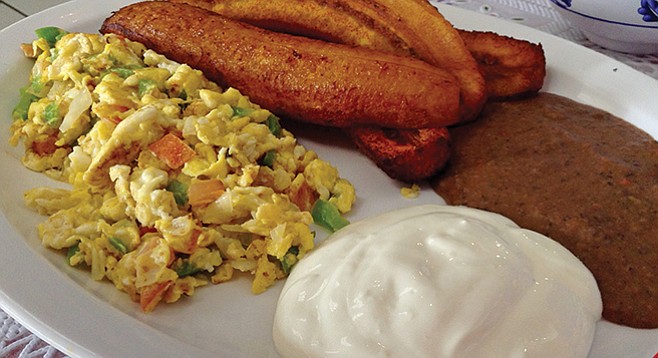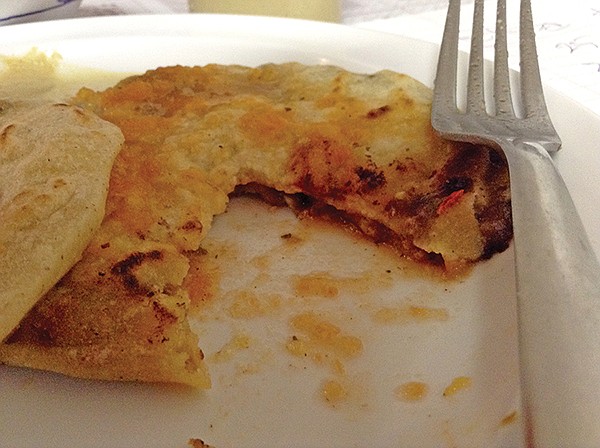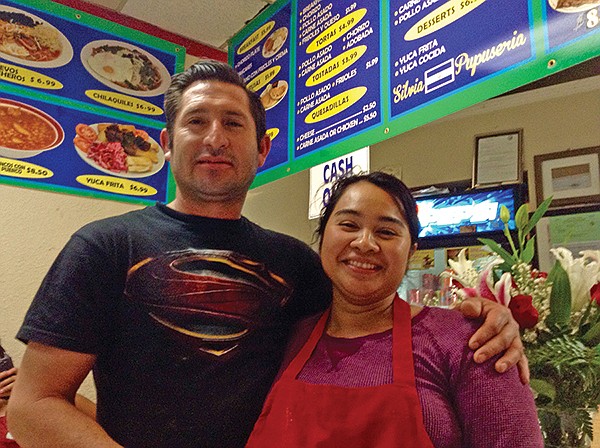 Facebook
Facebook
 X
X
 Instagram
Instagram
 TikTok
TikTok
 Youtube
Youtube

"You can sit over here if you like,” says this guy over in the booth. He’s noticed me craning my head to catch the Costa Rica game. Against mighty Colombia. Copa América. David and Goliath.
So I’m just taking him up on his invitation, when the game announcer starts yelling “Johan Venegas! Venegas… Goooooo-oaoaoaoaoallllllllllll!” I see the replay. Venegas, in Costa Rica’s red-and-blue colors, rockets a curveball to the top corner of Colombia’s net.
I don’t know if it’s just that Costa Rica’s the David in this contest or that we’re in this Salvadoran eatery and El Salvador’s about the same size as Costa Rica, but you get the feeling everyone here’s with the little guy.
It’s Saturday night. This place is busy. Which says a lot, because it’s stuck in a low-slung strip mall called “Highland View Center,” just up from Highland Avenue. “Autentica Comida Salvadoreña,” reads the sign over the store. That does it for me. I was in El Salvador once. Discovered fruits you never hear of. Marañon, the cashew fruit, with yellow flesh and then a nut at the end. Mamey, guinep, honey tamarinds, maracuya.
Inside’s all fresh, new. Cream walls, blue-and-white Salvadoran flag, green and white tiles, and a sign over the counter: “Cash only.”
I check the menu boards on the wall and see they have breakfasts still going. All cost $5.99. A chorizo plate, a pancake plate, and, hey, a third one: “Platano con frijoles y crema.”
Fried plantain. Definitely Central America. “The plate’s got fried plantain, refried beans, crema, and an egg scramble with things like peppers, onions, tomatoes, and chilies mixed in,” said Nancy, the cashier.
I have to have that, just for the fried plantain.

But then I remember. This is a pupuseria. Can’t come and not have El Salvador’s national dish. Especially as pupusas are only $1.99 each. Nancy says the most popular one is the revuelta, scrambled. Turns out to be a round gordita-like package of refried beans, cheese, and chicharrón. Except this chicharrón isn’t the Mexican fried pork rind, it’s the Central America definition: seasoned pork meat cooked and ground to a paste.
So, okay, I order one revuelta pupusa, and one more. The other choices include pupusas with chicharrón, loroco, cheese and beans, cheese with jalapeños, spinach, or nopal (cactus).
Loroco? It’s a Salvadoran vine flower that you can fry or pickle and add to the pupusa.
Drink-wise, I notice a pitcher of bright orange-colored water.
“That’s our refresco de ensalada,” says Nancy. “It’s a fruit-salad mix of marañon, mamey apples, mango, piña.”
I ask for one. It’s $1.50 and, man, the most refreshing, taste-tingling drink I’ve had in a long time. Has that addictive taste-rush you get with some tropical fruit like guava.
So, I come over with my drink, sit down across from Rogelio. We shake hands. “People call me Roger,” he says. “My wife helps in the kitchen here.”
I ask if he’s from El Salvador. “No, I’m Mexican-American. My wife Eloisa, too. But she’s cooking Salvadoran for Silvia.”
He’s just finished a fish pupusa with rice and beans. Dang. Didn’t see that one. While I wait, and with flicks of attention to the soccer, he tells me the incredible story of how he had to start working in Mexico at age 11, lifting concrete and stinking garbage bags onto trucks, day in, day out. And how now, a couple of decades later, he’s here, bringing in $300K as a building contractor.

Then the food comes out in the hands of Adolfo, the Mexican husband of Silvia the salvadoreña who started this restaurant. He brings my breakfast and two pupusas.
There’s a bit of ceremony here: I add the frijoles and crema, top them with some peanut-and-jalapeño salsa (hot! Sabroso!), or the tomatillo-and-habanero green salsa (hot-ish), then add the eggs. Oh, yes. The whole sweet-savory thing comes alive in your mouth.
But the plantain? Not for Roger. “When I was growing up in Guerrero, we were so poor,” he says. “My grandma used to make soups of meat bones, and to make them go further, she’d add plantains or bananas. So I always think of them like that.”
“But plantain, yucca, pupusas, these are the sentimental foods that people from El Salvador, Honduras, Guatemala come here for,” says Silvia. “These foods we cook, they are ancient, and more saludables, healthful, than Mexican or American food. Mayan people were cooking pupusas the same way 2000 years ago.”
So, the ceremony: for starters, you’ve gotta freshen your taste buds with the bowl you get of curtido, shredded, lightly fermented red cabbage. It’s like kimchee or sauerkraut, but less raucous. Then you’ve got to pour some of what looks like a bowl of watery red salsa over the pupusa.
“This?” says Roger. “The world’s original tomato sauce.”
Of course: ketchup didn’t start with Heinz. It started with the Central Americans who developed the tomato and made a sauce of it. Did the conquistadors realize they had something way more valuable than gold when they introduced the humble tomato to Europe?
So, yeah, more watery, but this salsa de tomate rojo adds flavor and liquid to my cactus pupusa. And some peppery heat.
I mean, this nopal pupusa is okay, but Rogelio’s right. The revuelta’s the real deal. Its combo of pork paste — chicharrón, Central America-style — cheese and beans, plus the salsa on top makes my pupusa feel nice and rich and with all that history, kind of important. Sweetness of the ensalada drink helps, too.
By the time I leave, the soccer game’s over (Costa Rica beat Colombia 3-2). And I’m already thinking about next time. Loroco pupusa? Fried yucca dessert? Get Carla to come? For sure, this is her kind of place.
Hours: 9:30 a.m.–9 p.m. daily
Prices: Breakfast plantain with beans, cream, scrambled eggs, $5.99; pupusas, $1.99, including revuelta, chicharrón, loroco; tacos, including adobada, carne asada, $1.99; steak, rice, beans, $6.99; liver steak, $6.99; fish soup, $8.25; chicken breast a la plancha, $8.25; chicken stew, $8.25
Buses: 929, 955
Nearest bus stop: E. 8th Street and Highland Avenue
Trolley: Blue Line
Nearest Trolley Stop: 8th Street Transit Center, National City (reach via 955 bus)


"You can sit over here if you like,” says this guy over in the booth. He’s noticed me craning my head to catch the Costa Rica game. Against mighty Colombia. Copa América. David and Goliath.
So I’m just taking him up on his invitation, when the game announcer starts yelling “Johan Venegas! Venegas… Goooooo-oaoaoaoaoallllllllllll!” I see the replay. Venegas, in Costa Rica’s red-and-blue colors, rockets a curveball to the top corner of Colombia’s net.
I don’t know if it’s just that Costa Rica’s the David in this contest or that we’re in this Salvadoran eatery and El Salvador’s about the same size as Costa Rica, but you get the feeling everyone here’s with the little guy.
It’s Saturday night. This place is busy. Which says a lot, because it’s stuck in a low-slung strip mall called “Highland View Center,” just up from Highland Avenue. “Autentica Comida Salvadoreña,” reads the sign over the store. That does it for me. I was in El Salvador once. Discovered fruits you never hear of. Marañon, the cashew fruit, with yellow flesh and then a nut at the end. Mamey, guinep, honey tamarinds, maracuya.
Inside’s all fresh, new. Cream walls, blue-and-white Salvadoran flag, green and white tiles, and a sign over the counter: “Cash only.”
I check the menu boards on the wall and see they have breakfasts still going. All cost $5.99. A chorizo plate, a pancake plate, and, hey, a third one: “Platano con frijoles y crema.”
Fried plantain. Definitely Central America. “The plate’s got fried plantain, refried beans, crema, and an egg scramble with things like peppers, onions, tomatoes, and chilies mixed in,” said Nancy, the cashier.
I have to have that, just for the fried plantain.

But then I remember. This is a pupuseria. Can’t come and not have El Salvador’s national dish. Especially as pupusas are only $1.99 each. Nancy says the most popular one is the revuelta, scrambled. Turns out to be a round gordita-like package of refried beans, cheese, and chicharrón. Except this chicharrón isn’t the Mexican fried pork rind, it’s the Central America definition: seasoned pork meat cooked and ground to a paste.
So, okay, I order one revuelta pupusa, and one more. The other choices include pupusas with chicharrón, loroco, cheese and beans, cheese with jalapeños, spinach, or nopal (cactus).
Loroco? It’s a Salvadoran vine flower that you can fry or pickle and add to the pupusa.
Drink-wise, I notice a pitcher of bright orange-colored water.
“That’s our refresco de ensalada,” says Nancy. “It’s a fruit-salad mix of marañon, mamey apples, mango, piña.”
I ask for one. It’s $1.50 and, man, the most refreshing, taste-tingling drink I’ve had in a long time. Has that addictive taste-rush you get with some tropical fruit like guava.
So, I come over with my drink, sit down across from Rogelio. We shake hands. “People call me Roger,” he says. “My wife helps in the kitchen here.”
I ask if he’s from El Salvador. “No, I’m Mexican-American. My wife Eloisa, too. But she’s cooking Salvadoran for Silvia.”
He’s just finished a fish pupusa with rice and beans. Dang. Didn’t see that one. While I wait, and with flicks of attention to the soccer, he tells me the incredible story of how he had to start working in Mexico at age 11, lifting concrete and stinking garbage bags onto trucks, day in, day out. And how now, a couple of decades later, he’s here, bringing in $300K as a building contractor.

Then the food comes out in the hands of Adolfo, the Mexican husband of Silvia the salvadoreña who started this restaurant. He brings my breakfast and two pupusas.
There’s a bit of ceremony here: I add the frijoles and crema, top them with some peanut-and-jalapeño salsa (hot! Sabroso!), or the tomatillo-and-habanero green salsa (hot-ish), then add the eggs. Oh, yes. The whole sweet-savory thing comes alive in your mouth.
But the plantain? Not for Roger. “When I was growing up in Guerrero, we were so poor,” he says. “My grandma used to make soups of meat bones, and to make them go further, she’d add plantains or bananas. So I always think of them like that.”
“But plantain, yucca, pupusas, these are the sentimental foods that people from El Salvador, Honduras, Guatemala come here for,” says Silvia. “These foods we cook, they are ancient, and more saludables, healthful, than Mexican or American food. Mayan people were cooking pupusas the same way 2000 years ago.”
So, the ceremony: for starters, you’ve gotta freshen your taste buds with the bowl you get of curtido, shredded, lightly fermented red cabbage. It’s like kimchee or sauerkraut, but less raucous. Then you’ve got to pour some of what looks like a bowl of watery red salsa over the pupusa.
“This?” says Roger. “The world’s original tomato sauce.”
Of course: ketchup didn’t start with Heinz. It started with the Central Americans who developed the tomato and made a sauce of it. Did the conquistadors realize they had something way more valuable than gold when they introduced the humble tomato to Europe?
So, yeah, more watery, but this salsa de tomate rojo adds flavor and liquid to my cactus pupusa. And some peppery heat.
I mean, this nopal pupusa is okay, but Rogelio’s right. The revuelta’s the real deal. Its combo of pork paste — chicharrón, Central America-style — cheese and beans, plus the salsa on top makes my pupusa feel nice and rich and with all that history, kind of important. Sweetness of the ensalada drink helps, too.
By the time I leave, the soccer game’s over (Costa Rica beat Colombia 3-2). And I’m already thinking about next time. Loroco pupusa? Fried yucca dessert? Get Carla to come? For sure, this is her kind of place.
Hours: 9:30 a.m.–9 p.m. daily
Prices: Breakfast plantain with beans, cream, scrambled eggs, $5.99; pupusas, $1.99, including revuelta, chicharrón, loroco; tacos, including adobada, carne asada, $1.99; steak, rice, beans, $6.99; liver steak, $6.99; fish soup, $8.25; chicken breast a la plancha, $8.25; chicken stew, $8.25
Buses: 929, 955
Nearest bus stop: E. 8th Street and Highland Avenue
Trolley: Blue Line
Nearest Trolley Stop: 8th Street Transit Center, National City (reach via 955 bus)
Comments